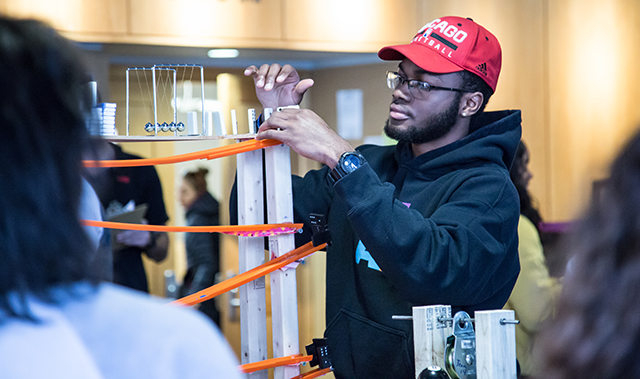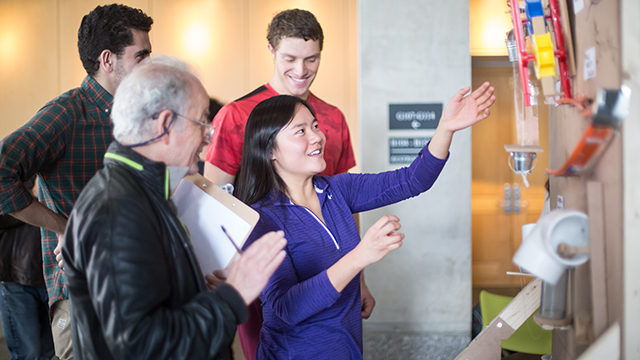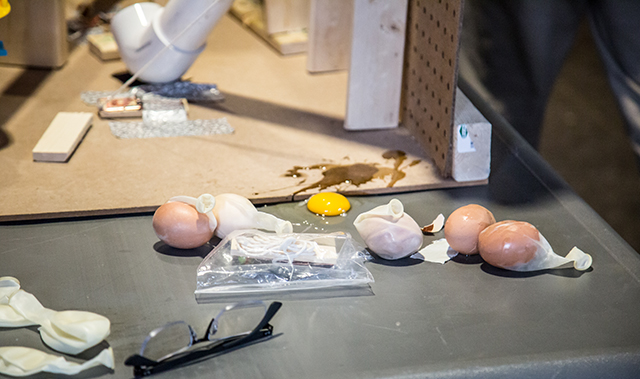News
Students build Rube Goldberg machines to test their knowledge of physics
Students fused multiple physics concepts and a variety of simple machines as they built Rube Goldberg machines for the course Physics as a Foundation for Science and Engineering (AP 50).
The course has helped students explore concepts in kinematics, momentum, oscillation, gravitation, and waves through a series of collaborative projects. In their second project of the term, students used a chain reaction of motions to crack an egg.
Kelly Miller, Senior Preceptor in Applied Physics at the Harvard John A. Paulson School of Engineering and Applied Sciences, who leads the course, said, “The objective of the project is for students to develop a richer understanding of physics in a hands-on way.”
The hand-on nature of the course draws students from a number of different concentrations, and the machines on display at the annual Rube-a-Thon were as diverse as their creators.

Uzochi Nwoko, A.B. '20, an integrative biology concentrator, sets up the dominos for the chain reaction set off by his team's Rube Goldberg machine. (Photo by Annie Schugart/SEAS Communications)
Julia Riew, A.B. ‘21, a joint concentrator in history of science and theater, dance, and media, said she watched many different Rube Goldberg videos before drawing up a design inspired by her favorites. Her team made many adjustments, adding mousetraps to generate the force needed to drive a marble back up a track..
Her teammate, Mai-linh Ton, A.B. ‘19, a joint concentrator in human developmental and regenerative biology and visual and environmental studies, said its compactness made their project unique. She demonstrated how their chain of reactions ended with a false door being pulled out from under the egg, so that it dropped on a pointed weight. The team had drawn an egg with a halo on it, accurately anticipating their success in cracking the egg.
“I watched a lot of Mythbusters growing up, and I was glad to put it to use on this project,” Ton said.

Grace Matthews, A.B. '21, a biomedical engineering concentrator, displays and explains her team's Rube Goldberg machine. (Photo by Annie Schugart/SEAS Communications)
The 13th team in the lineup called themselves “Lucky Strike” for lucky number 13. Grace Matthews, A.B. ‘21, a biomedical engineering concentrator, demonstrated how they combined multiple dimensions of force to get a projectile to roll, so that in the end, their egg landed neatly into a waiting frying pan.
“The most important part was planning it. Implementation was easy after that,” said teammate, Ethan Seder, S.B. ’21, a mechanical engineering concentrator
Another team, called “Rube and the Goldbergs,” set up a chain of reactions that ended in an egg launch that bioengineering concentrator Lucas Clarke, S.B. ’21, said was his favorite part.
“Bringing our project to life was much better than memorizing for a test. It’s helped me understand how physics works in the real world,” said teammate, Ryan Bayer, A.B. ’21, an economics concentrator.
For these students, the chain reactions they designed set off a chain reaction of learning and a deep appreciation for physics concepts.

The eggy atermath of a successful Rube Goldberg machine. (Photo by Annie Schugart/SEAS Communications)
Topics: Academics, Applied Physics
Cutting-edge science delivered direct to your inbox.
Join the Harvard SEAS mailing list.


